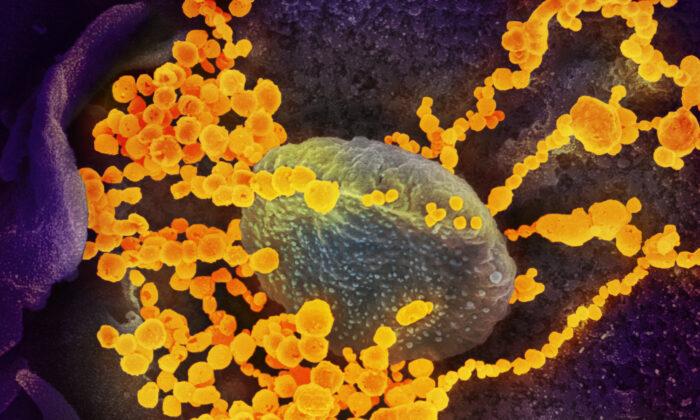Some patients who were infected with the SARS-CoV-2 have had difficulty getting rid of some symptoms such as fatigue, brain fog, and heart pain. This prolonged condition is known as “long COVID.”
However, some people who have had COVID vaccinations rather than infection have similar symptoms.
This is due to the spike proteins that remain in the body after both after vaccination or infection with the virus.
Spike proteins are the “keys” to viral invasion of our cells, so we will discuss how the spike proteins work, antidotes to detoxify spike proteins, and nutrients that inhibit their toxic effect.
Spike proteins are small mushroom-like bumps on the surface of the SARS-CoV-2 virus. They’re like a key that opens the door for the virus to enter cells, which are then infected by the virus.
Previously, scientists believed that the spike protein itself was harmless to the human body.
The mRNA vaccines were designed based on the mRNA sequence code of the SARS-CoV-2 spike protein. The original intention was to let the mRNA in the vaccines enter human cells and produce a large amount of spike proteins, which would stimulate immune cells and induce them to produce antibodies to neutralize the SARS-CoV-2 virus particles in the bloodstream.
However, a growing number of cases and studies have revealed that the stimulation by spike proteins to produce antibodies can also cause varying degrees of damage to human cells.
Impairing Mitochondria and Damaging Organs
In April 2021, a study published in Circulation Research found that spike proteins disrupt the structure and functions of mitochondria in cells.Mitochondria are the energy centers of cells. Once mitochondria’s functions are impaired, cells cannot function properly. If a large area of liver cells or heart muscle cells are not working properly, the organs’ functions can become impaired. This is one of the reasons why spike proteins cause symptoms like brain fog and heart failure.

Impairing DNA Self-Repair Mechanism
In a study published in the journal Viruses, laboratories from two Swedish universities reported that spike proteins would inhibit the ability of growing cells to repair DNA damages.The experiments investigated the non-homologous end joining (NHEJ) and homologous recombination (HR) functions of DNA in embryonic kidney cells. These are the two major self-repair pathways of mammalian cellular DNA.
It was discovered that in comparison with the control group, the spike proteins in three different states, including full-length spike protein, spike protein S1 subunit and S2 subunit, caused severe damage to the innate ability of mammalian DNA to self-repair, with the full-length spike protein causing particularly severe damage.
This study involves the ability of human DNA to repair itself. And so far, we have only preliminary results from cell models. However, this is a very important topic and warrants more follow-up research by the medical community.

For some unclear reasons, this paper has been retracted, but we can still access the full report online.
Organs to Which the Spike Proteins Are Distributed
Before a new drug or vaccine can be approved by the Food and Drug Administration (FDA), an important document on its biodistribution called a “pharmacokinetics profile” must be submitted, in order to report the process about how the drug or vaccine is released, absorbed, distributed, metabolized in and excreted from the body.This study involved the use of isotopically labeled mRNA for the experiments. Since isotopes are harmful to humans, the experiments were conducted on rats.
The rats were injected with 50 micrograms of mRNA vaccine. After 15 minutes, in addition to having a relatively high concentration at the injection site, the vaccine began to disperse to different organs throughout the body, reaching the liver and spleen first.
After an hour, the concentration of the vaccine in the liver and spleen increased further, and it reached the adrenal glands and bone marrow.
After 24 hours, the researchers examined the distribution of the mRNA vaccine in the rats and found that in addition to the highest level at the injection site, the next highest levels were in the spleen, liver, adrenal glands, ovaries, bone marrow, lymph nodes, kidneys, muscles, and heart, in order of the concentration.

The spleen and liver are the two organs that have a key influence on immunity.
- Immune system: It affects the lymph and impairs the functions of immune cells in the spleen, resulting in decreased immune system functions and possible activation of latent viruses, such as the herpes virus.
- Liver: The toxin has the most direct effect on the liver, causing autoimmune liver damage.
- Myocardial cells: It causes inflammation of the heart cells, leading to myocarditis and pericarditis.
- Nervous system: It causes brain fog and memory loss.
However, not everyone will have these problems after vaccination, as any kind of disease has both internal and external contributors. For example, there are many intrinsic factors including gender, age, inflammatory status, cellular stress level, nutritional status, epigenetics, genetics, etc, etc.
Guideline for Detoxification of Spike Proteins
The World Health Council (WCH) has published guidelines for the detoxification of spike proteins. In conjunction with this guidance, we have summarized two strategies based on the available research data to address the damage caused by the SARS-CoV-2 virus spike protein: Western medicine and natural herbs.Ivermectin
Ivermectin is a compound that originated from nature.Satoshi Omura, a Japanese microbiologist and organic chemist, who grew up in a farmer’s family, discovered from soil samples the predecessor compound of ivermectin, Streptomyces Avermectinius, and modified it into ivermectin.

Ivermectin has been in use for more than 50 years. Ivermectin was first used in the treatment of parasitic diseases, such as onchocerciasis, river blindness, and elephantiasis.
In addition to treating parasites, in vitro cellular experiments have revealed that ivermectin has broad-spectrum antiviral effects. It can be used to fight against RNA viruses (including HIV, the dengue fever virus, influenza viruses) and DNA viruses.
In addition, ivermectin has a variety of antiviral mechanisms. It can also inhibit viral entry into cells and viral protease function, thus blocking viral replication.


In the absence of contraindications, ivermectin was offered as an optional treatment to be taken for two consecutive days every 15 days at a dose of 0.2 mg/kg/day.
Of the 223,128 citizens of Itajaí considered for the study, a total of 159,561 subjects were included in the analysis: 113,845 (71.3 percent) regular ivermectin users and 45,716 (23.3 percent) non-users. The main findings are: The regular use of ivermectin at 0.2 mg/kg/day for 2 days every 15 days led to a 68 percent reduction in COVID-19 mortality (0.8 percent versus 2.6 percent among ivermectin non-users; p < 0.0001). There was a 56 percent reduction in hospitalization rate (p < 0.0001).

Suramin
Suramin is a century-old medicine that was also first used to treat the parasitic worm disease called onchocerciasis. In addition to treating parasitic diseases, it has been proven effective in inhibiting the replication of many viruses, including enterovirus, Zika virus, and Ebola virus.
Suramin also has multiple antiviral mechanisms, including inhibition of virus attachment, and entry and release from cells, in part through interactions with viral capsid proteins.

Most of the data on Suramin are derived from the in vitro studies. In theory, it should work for reducing the spike in protein toxicity. As there is no clinical trial data to confirm the effects on reducing the spike protein toxicity, an instruction under a doctor’s advice must be followed.
NAC (N-acetyl-L-cysteine)
This drug is a well-established expectorant, which is able to reduce the stickiness of sputum, as well as an antioxidant.Although it’s unable to interfere with the binding of spike proteins to ACE2 receptors, it reduces the oxidation of spike proteins after they enter the cells. As a neutralizing agent, it can reduce the consequences of toxicity after poisoning.

NAC, on the other hand, has a restorative effect on cells. It’s able to restore cells damaged by spike proteins to almost the same state as normal cells.
Plants and Herbs
Since ancient times, botanicals and herbs have been traditional tools used by people around the world for health care.Catechin and Curcumin
Catechin, a tea extract, is a natural antioxidant that accounts for about 75 percent to 80 percent of the polyphenol content of tea and is one of the sources of the bitterness of tea.Curcumin, derived from turmeric, is an important component of curry. Curcumin has powerful antioxidant and anti-inflammatory properties.

Carpenter’s Herb
Carpenter’s herb (Prunella vulgaris) has long been considered an effective medicine for liver health.
Some other herbs, such as pine needles, emodin, neem, and dandelion leaf extract, are also mentioned in the WCH guidelines as having similar effects in relieving the toxicity of spike proteins.
Increasingly, scientific studies are finding that there are more herbal ingredients that have inhibitory effects on the SARS-CoV-2 and can repair the damage caused by vaccination.

Chinese herbal medicine is an important resource that is closely related to human health.
Isn’t it an interesting phenomena that in our nature, there are so many natural compounds that could help people fight against viruses and virus-related health issues?
Nature has created an environment, in which there are viruses, bacteria, and parasites that are harmful to the human body, but it also contains natural compounds that can help people fend off the invasions and infections by these foreign microorganisms.
In such an environment of generation and restriction, we can learn to maintain our health and stay away from viruses and diseases. However, if we do not know how to maintain our health “account” and exhaust our bodies (overdraft), we will get sick.
In the face of the COVID pandemic, our situation seems to be getting increasingly difficult, but it is not necessarily due to the virus becoming stronger than before, rather, it may be because we have forgotten as a whole the ways to take care of our own bodies and have become less healthy as a whole.
https://www.ahajournals.org/doi/epub/10.1161/CIRCRESAHA.121.318902
https://www.mdpi.com/1999-4915/13/10/2056
https://phmpt.org/wp-content/uploads/2022/03/125742_S1_M4_4223_185350.pdf
https://iv.iiarjournals.org/content/34/5/3023.long
https://www.ncbi.nlm.nih.gov/pmc/articles/PMC7129059/
https://www.cureus.com/articles/82162-ivermectin-prophylaxis-used-for-covid-19-a-citywide-prospective-observational-study-of-223128-subjects-using-propensity-score-matching
https://www.nature.com/articles/s41594-021-00570-0
https://www.ahajournals.org/doi/epub/10.1161/CIRCRESAHA.121.318902
https://pubmed.ncbi.nlm.nih.gov/24142193/
https://www.nature.com/articles/s41598-021-81462-7
https://journals.plos.org/plosone/article?id=10.1371/journal.pone.0251649
https://www.mdpi.com/1424-8247/14/8/742






